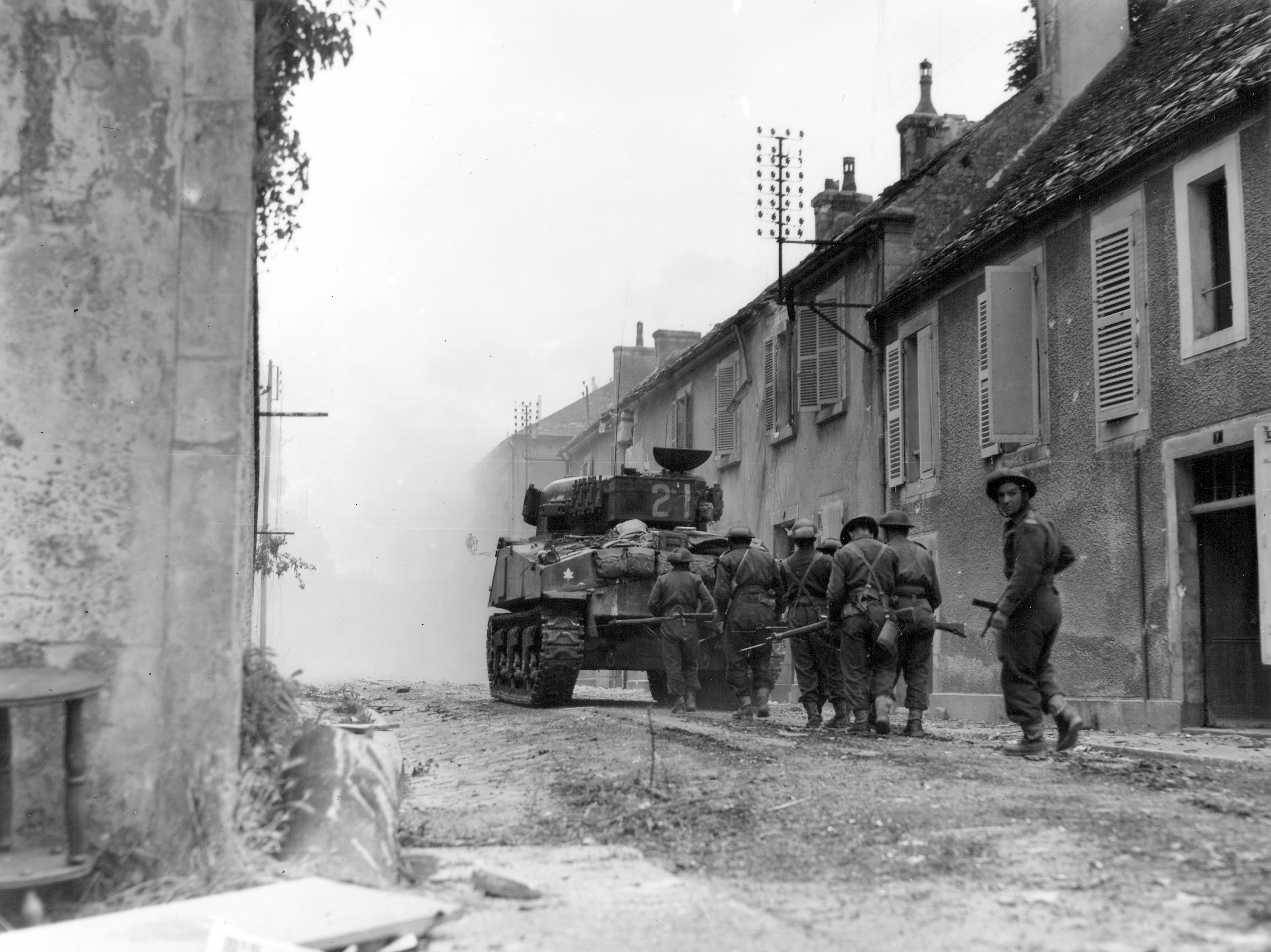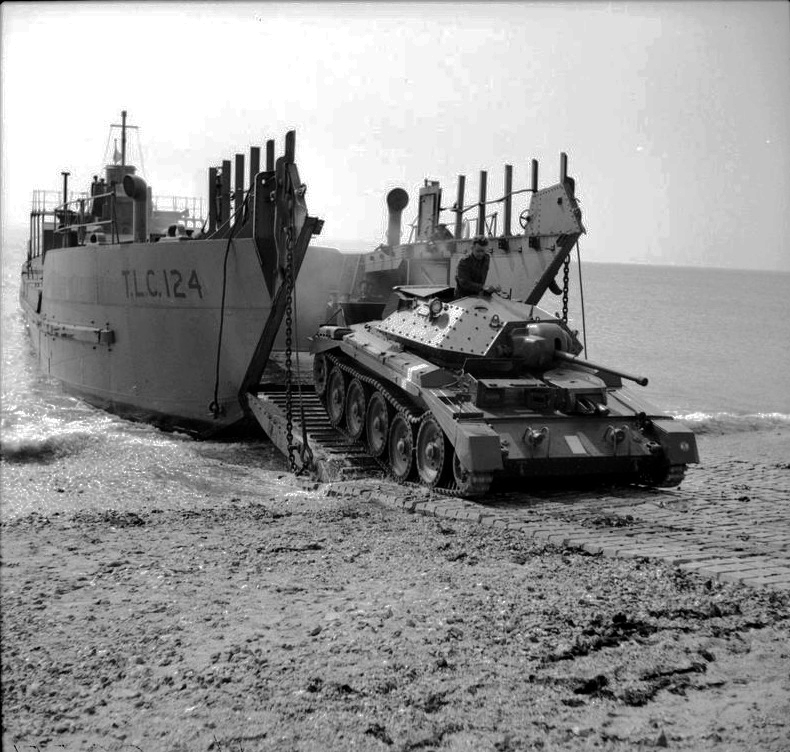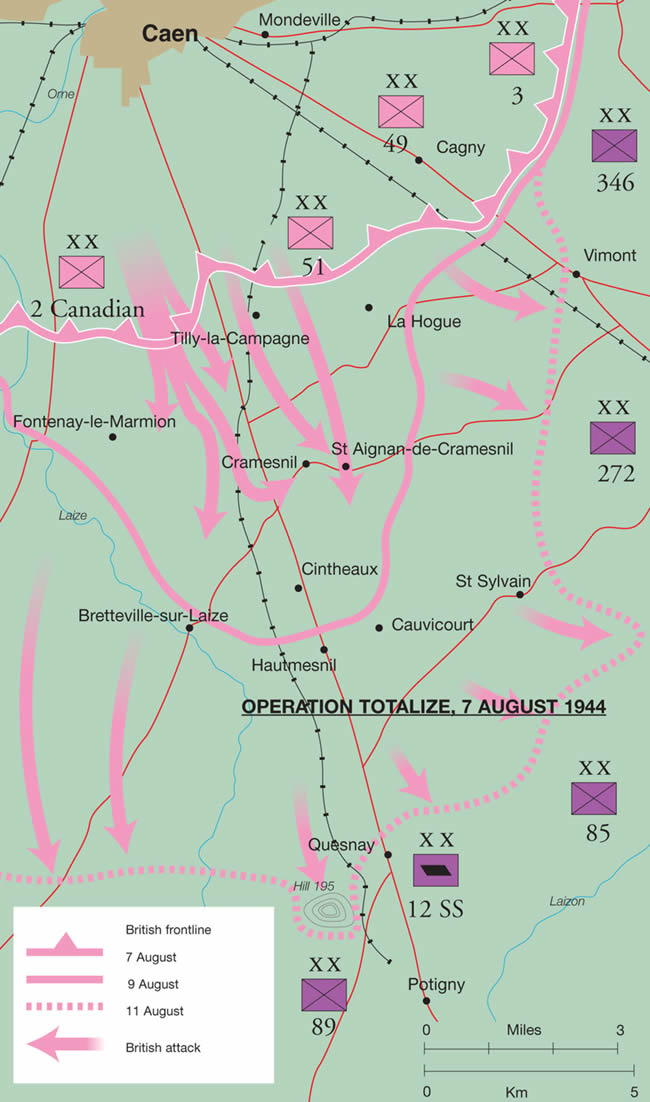|
Sherbrooke Fusilier Regiment
The Sherbrooke Fusilier Regiment was a Second World War Canadian armoured regiment created in 1940 with officers and men from two Militia regiments in Sherbrooke, Quebec. The name is a blend of Les Fusiliers de Sherbrooke, a francophone infantry unit, and the Sherbrooke Regiment, an English-speaking machine gun unit. The armoured corps lineage of the Sherbrooke Fusilier Regiment is carried forward by the present-day reserve regiment, The Sherbrooke Hussars. Sydney Valpy Radley-Walters, later Director-General Training and Recruiting Canadian Forces, was during the war an officer of the regiment. He had three tanks shot out from under him and was wounded twice. He ended the war a lieutenant-colonel decorated with a Military Cross and Distinguished Service Order. The second most important artifact from the Second World War, after the guidon, is a Bomb (tank), Sherman tank named "Bomb" which landed in Normandy on 6 June and served on the front lines throughout the campaigns until ... [...More Info...] [...Related Items...] OR: [Wikipedia] [Google] [Baidu] |
Bomb (tank)
''Bomb'' is a preserved M4 Sherman tank. It was used by the Canadian Army Sherbrooke Fusilier Regiment, 27th Armoured Regiment (The Sherbrooke Fusilier Regiment) which landed in France on 6 June and fought across northwest Europe until the end of World War II. It was one of the few Canadian tanks that fought without interruption from D-Day to Victory in Europe Day, VE Day. Today ''Bomb'' is preserved at the William Street Armoury in Sherbrooke, Quebec. Origins ''Bomb'' was built at General Motors' Fisher Tank Arsenal in Flint, Michigan as an M4A2 Sherman Tank, serial number 8007. It was shipped to England, where it was issued with the War Department number T-152656. The tank was assigned to B Squadron of the Sherbrooke Fusiliers as the regiment converted from older training tanks to new Shermans in preparation for the invasion of France as part of the 2nd Canadian Armoured Brigade. The tanks of B Squadron all had names that started with ''B'' such as ''Barbara'' and ''Be Good' ... [...More Info...] [...Related Items...] OR: [Wikipedia] [Google] [Baidu] |
Landing Craft, Tank
The Landing Craft, Tank (LCT) (or tank landing craft, TLC) was an amphibious assault craft for landing tanks on beachheads. They were initially developed by the Royal Navy and later by the United States Navy during World War II in a series of versions. Initially known as the "tank landing craft" (TLC) by the British, they later adopted the U.S. nomenclature "landing craft, tank" (LCT). The United States continued to build LCTs post-war, and used them under different designations in the Korean and Vietnam Wars. Development In 1926, the first motor landing craft (MLC1) was built by the Royal Navy. It weighed 16 tons, with a draught of , and was capable of about . It was later developed into the landing craft mechanised. It was at the insistence of the British prime minister Winston Churchill in mid-1940 that the LCT was created. Its speed was on engines delivering about . Designated the LCT Mark 1, 20 were ordered in July 1940 and a further 10 in October 1940.) Mark ... [...More Info...] [...Related Items...] OR: [Wikipedia] [Google] [Baidu] |
Operation Totalize
Operation Totalize (also spelled Operation Totalise in recent British sources) was an offensive launched by Allied troops in the First Canadian Army during the later stages of Operation Overlord, from 8 to 9 August 1944. The intention was to break through the Nazi Germany, German defences south of Caen on the eastern flank of the Allied positions in Normandy and exploit success by driving south, to capture the high ground north of the city of Falaise, Calvados, Falaise. The goal was to collapse the German front and cut off the retreat of German forces fighting the Allied Powers (World War II), Allied armies further west. The battle is considered the inaugural operation of the First Canadian Army, which had been activated on 23 July. In the early hours of 8 August 1944, II Canadian Corps launched the attack using mechanized infantry. They broke through the German front lines and captured vital positions deep in the German defences. It was intended that two fresh armoured division ... [...More Info...] [...Related Items...] OR: [Wikipedia] [Google] [Baidu] |
Panchromatic
A panchromatic emulsion is a type of photographic emulsion that is sensitive to all wavelengths of visible light, and produces a monochrome photograph—typically black and white. Most modern commercially available film is panchromatic, and the technology is usually contrasted with earlier methods that cannot register all wavelengths, especially orthochromatic film. In digital imaging, a panchromatic sensor is an image sensor or array of sensors that combine the visible spectrum with non-visible wavelengths, such as ultraviolet or infrared. Images produced are also black and white, and the system is used for its ability to produce higher resolution images than standard digital sensors. Description A panchromatic emulsion renders a realistic reproduction of a scene as it appears to the human eye, although with no colors. Almost all modern photographic film is panchromatic. Some older types of film were orthochromatic and were not sensitive to certain wavelengths of light. As ... [...More Info...] [...Related Items...] OR: [Wikipedia] [Google] [Baidu] |
William Abernethy Ogilvie
William Abernethy Ogilvie, (March 3, 1901 – August 28, 1989) was a Canadian painter and Official Second World War artist. Early life Ogilvie came to Canada in 1925 and after living in Toronto, went to New York from 1925–1930 to study at the Art Students League with Kimon Nicolaïdes, the author later of an important text on drawing, ''The Natural Way to Draw'' (1941). He worked briefly in New York as a commercial artist before returning to Toronto and joining Charles Comfort and Harold Ayres in a company which offered diverse skills, part advertising, part magazine illustration. In 1933, he was one of the founders of the Canadian Group of Painters and from 1933–1989, he was also a member of the Canadian Society of Painters in Water Colour. In 1936, he did murals for the Chapel of Hart House, University of Toronto. War artist After working at the Art Association of Montreal, Ogilvie joined the Canadian army in 1940 and was commissioned as the first Official War artis ... [...More Info...] [...Related Items...] OR: [Wikipedia] [Google] [Baidu] |
M10 Tank Destroyer
The M10 tank destroyer, formally known as 3-inch gun motor carriage M10 or M10 BBC, was an American tank destroyer of World War II. After US entry into World War II and the formation of the Tank Destroyer Force, a suitable vehicle was needed to equip the new battalions. By November 1941, the Army requested a vehicle with a gun in a fully rotating turret after other interim models were criticized for being too poorly designed. The prototype of the M10 was conceived in early 1942 and delivered in April that year. After appropriate changes to the hull and turret were made, the modified version was selected for production in June 1942 as the "3-inch Gun Motor Carriage M10". It mounted the 3-inch anti-aircraft gun M3, 3-inch (76.2 mm) gun M7 in a rotating turret on a modified M4 Sherman tank chassis. It was built in two variants. The M10 GMC used the M4A2 Sherman chassis and the M10A1 used the M4A3 chassis. Production of the two models ran from September 1942 to December 1943 and O ... [...More Info...] [...Related Items...] OR: [Wikipedia] [Google] [Baidu] |
Walter Brown (chaplain)
The Reverend Walter Leslie Brown (13 August 1910 – 6 June 1944) was a Canadian military chaplain who was attached to the Sherbrooke Fusilier Regiment, 2nd Canadian Armoured Brigade during Operation Overlord. He was murdered by Waffen-SS soldiers after he had surrendered. At the time of his capture he had been wearing the uniform of a Canadian army chaplain. History Walter Brown was born in Peterborough, Ontario on 13 August 1910, to English-born parents George Carmichael Brown and Florence May Brown (née Peters), although the family later settled in Orillia, Ontario. He had two brothers. An alumnus of Huron University College, he was already an ordained and practising minister of the Anglican Church in Canada, before he volunteered for service in the Canadian Army as part of the Canadian Chaplain Service on 1 April 1941 in Toronto, Ontario. He was eventually attached to an armoured regiment (the 27th Armoured Regiment (The Sherbrooke Fusilier Regiment)) slated to land ea ... [...More Info...] [...Related Items...] OR: [Wikipedia] [Google] [Baidu] |
Ardenne Abbey Massacre
The Ardenne Abbey massacre occurred during the Battle of Normandy at the Ardenne Abbey, a Premonstratensian monastery in Saint-Germain-la-Blanche-Herbe, near Caen, France. In June 1944, 20 Canadian soldiers were massacred in a garden at the abbey by members of the 12th SS Panzer Division ''Hitlerjugend'' over the course of several days and weeks. This was part of the Normandy Massacres, a series of scattered killings during which up to 156 Canadian prisoners of war were murdered by soldiers of the 12th SS Panzer Division during the Battle of Normandy. The perpetrators of the massacre, members of the 12th SS Panzer Division, were known for their fanaticism, the majority having been drawn from the ''Hitlerjugend'' or Hitler Youth. POW killings During the Normandy Campaign, Waffen-SS '' Standartenführer'' Kurt Meyer, commander of the 12th SS Panzer Division Hitlerjugend, used the Abbaye d’Ardenne for his regimental headquarters, as its towers gave a clear view of the batt ... [...More Info...] [...Related Items...] OR: [Wikipedia] [Google] [Baidu] |
Caen – Carpiquet Airport
Caen (; ; ) is a commune inland from the northwestern coast of France. It is the prefecture of the department of Calvados. The city proper has 105,512 inhabitants (), while its functional urban area has 470,000,Comparateur de territoire , INSEE, retrieved 20 June 2022. making Caen the second largest urban area in and the 19th largest in France. It is also the third largest commune in all of Normandy after and |
Villons-les-Buissons
Villons-les-Buissons () is a commune in the Calvados department in the Normandy region in northwestern France. Population See also *Communes of the Calvados department The following is a list of the 526 Communes of France, communes of the Calvados (department), Calvados Departments of France, department of France. The communes cooperate in the following Communes of France#Intercommunality, intercommunalities ... References Communes of Calvados (department) Calvados communes articles needing translation from French Wikipedia {{Caen-geo-stub ... [...More Info...] [...Related Items...] OR: [Wikipedia] [Google] [Baidu] |
9th Canadian Infantry Brigade
The 9th Canadian Infantry Brigade was an infantry brigade of the Canadian Army that saw active service during World War I and World War II as part of the 3rd Canadian Infantry Division. The brigade fought on the Western Front during World War I from January 1916 to November 1918, and in Normandy and north-west Europe in 1944–1945 during World War II. It was a square formation of four infantry battalions during World War I, but was reduced to a triangular formation of three battalions during World War II. History World War I Formation During World War I, the brigade was formed as part of the 3rd Canadian Division. Placed under the leadership of Brigadier-General Frederic William Hill, it initially consisted of the 43rd, 52nd, 58th and 60th Battalions, which came respectively from Winnipeg, Port Arthur, the Niagara area and Montreal. The unit sailed to France from Southampton late in February. Thereafter, it travelled to its billets In European militaries, a billet is ... [...More Info...] [...Related Items...] OR: [Wikipedia] [Google] [Baidu] |






